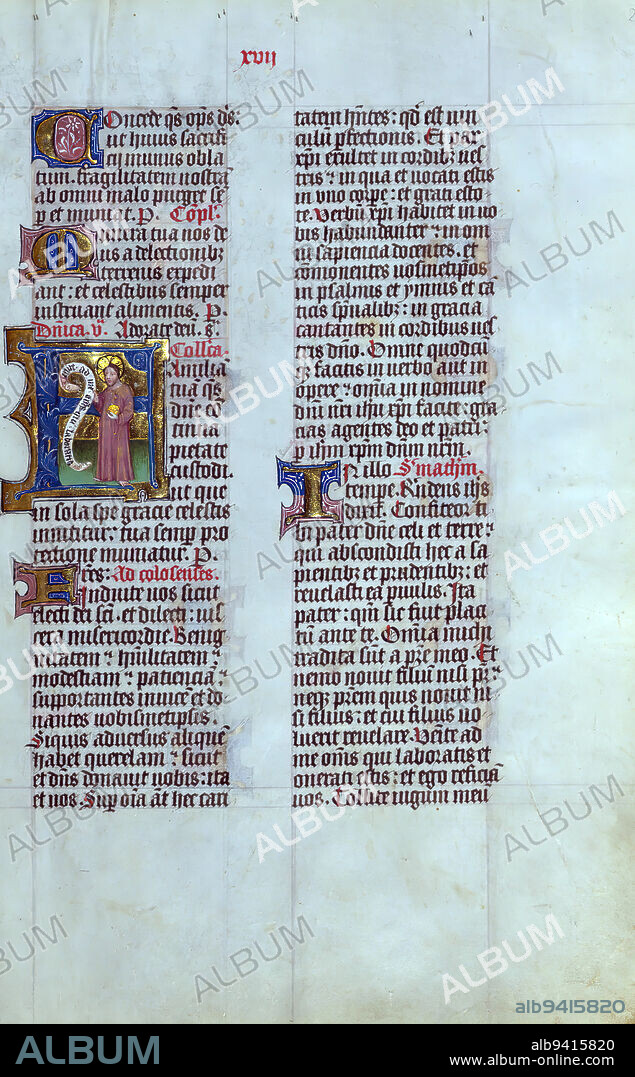alb9415820
Missal of Eberhard von Greiffenklau, Christ holding the Orb and blessing, with a scroll inscribed with a quotation from Matt. 11:28, 'Venite ad me omnes qui laboravi', The Missal of Eberhard von Greiffenklau is a masterpiece of Dutch manuscript painting. It was originally produced in the second quarter of the fifteenth century for von Greiffenklau, prebendary of Utrecht from 1446. The manuscript features work by the Masters of Zweder van Culemborg, active in the Utrecht area between 1420 and 1440, so-named after the Bishop of Utrecht 1425-33 for whom they produced a magnificent Missal in the late 1420s (now Bressanone, Bibl. del Seminario Maggiore). This Missal also features work by the celebrated Master of Catherine of Cleves, linking it to possibly the finest Dutch illuminated manuscript ever made; the Hours of Catherine of Cleves of c.1440. This extremely elaborate Missal is illuminated with one full-page miniature, 52 column miniatures and 68 historiated initials throughout the manuscript, with the Temporal and Sanctoral sections being particularly richly decorated. In the late 15th century, a selection of prayers and sequences were added to the end of the manuscript in Germany, probably Mainz, and the volume was subsequently rebound with its current brown calf over boards, blind, rebacked binding either at that time or in the early 16th century.

|
Ajouter à une autre Lightbox |
|
Ajouter à une autre Lightbox |



Avez-vous déjà un compte? S'identifier
Vous n'avez pas de compte ? S'inscrire
Acheter cette image.
Sélectionnez l'usage:

Légende:
Voir la traduction automatique
Missal of Eberhard von Greiffenklau, Christ holding the Orb and blessing, with a scroll inscribed with a quotation from Matt. 11:28, 'Venite ad me omnes qui laboravi', The Missal of Eberhard von Greiffenklau is a masterpiece of Dutch manuscript painting. It was originally produced in the second quarter of the fifteenth century for von Greiffenklau, prebendary of Utrecht from 1446. The manuscript features work by the Masters of Zweder van Culemborg, active in the Utrecht area between 1420 and 1440, so-named after the Bishop of Utrecht 1425-33 for whom they produced a magnificent Missal in the late 1420s (now Bressanone, Bibl. del Seminario Maggiore). This Missal also features work by the celebrated Master of Catherine of Cleves, linking it to possibly the finest Dutch illuminated manuscript ever made; the Hours of Catherine of Cleves of c.1440. This extremely elaborate Missal is illuminated with one full-page miniature, 52 column miniatures and 68 historiated initials throughout the manuscript, with the Temporal and Sanctoral sections being particularly richly decorated. In the late 15th century, a selection of prayers and sequences were added to the end of the manuscript in Germany, probably Mainz, and the volume was subsequently rebound with its current brown calf over boards, blind, rebacked binding either at that time or in the early 16th century.
Personnalités:
Crédit:
Album / quintlox
Autorisations:
Taille de l'image:
3046 x 4914 px | 42.8 MB
Taille d'impression:
25.8 x 41.6 cm | 10.2 x 16.4 in (300 dpi)
Mots clés:
15 15E 15EME XV XVE XVEME SIECLE • 15E SIECLE • 15EME S • ACTIVE • ALLEMAGNE • BENEDICTION • BÉNIR • CHRÉTIEN • CHRETIEN, CULTE • CHRÉTIENNE • CHRÉTIENS • CIEL ORAGE • CLERGE EVEQUE • CULTE: CHRETIEN • ECRITURE LIVRES • ENLUMINURE • EPOQUE RENAISSANCE • EVEQUE • HEURE • HOLLANDAIS • HOLLANDAISE • ILLUMINATION (ECLAIRAGE) • ILLUMINATION • LITURGIE • LIVRE (OUVRAGE) • LIVRE • LIVRES • MAT • MINIATURE • ORAGE • ORAGES • POTEAU • QUINZIÈME SIÈCLE • RELIGION: CHRETIENNE • RENAISSANCE • RENNAISSANCE • SELECTION • TEMPETE • TEMPS • TEXTURE • VETEMENT: HOLLANDAIS • XVE SIECLE • ZWEDER VAN CULEMBORG
 Pinterest
Pinterest Twitter
Twitter Facebook
Facebook Copier le lien
Copier le lien Email
Email
